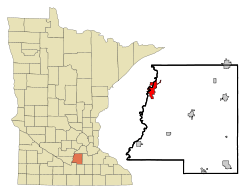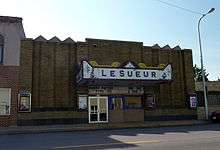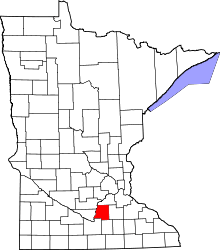Le Sueur, Minnesota
| Le Sueur, Minnesota | |
|---|---|
| City | |
| Motto: Valley of the Jolly Green Giant | |
 Location of Le Sueur within Le Sueur and Sibley Counties in the state of Minnesota | |
| Coordinates: 44°27′57″N 93°54′32″W / 44.46583°N 93.90889°WCoordinates: 44°27′57″N 93°54′32″W / 44.46583°N 93.90889°W | |
| Country | United States |
| State | Minnesota |
| Counties | Le Sueur, Sibley |
| Government | |
| • Type | Mayor – Council |
| • Mayor | Robert Broeder |
| Area[1] | |
| • Total | 5.62 sq mi (14.56 km2) |
| • Land | 5.37 sq mi (13.91 km2) |
| • Water | 0.25 sq mi (0.65 km2) |
| Elevation | 774 ft (236 m) |
| Population (2010)[2] | |
| • Total | 4,058 |
| • Estimate (2012[3]) | 4,029 |
| • Density | 755.7/sq mi (291.8/km2) |
| Time zone | Central (CST) (UTC-6) |
| • Summer (DST) | CDT (UTC-5) |
| ZIP code | 56058 |
| Area code(s) | 507 |
| FIPS code | 27-36746[4] |
| GNIS feature ID | 0654787[5] |
| Website | www.cityoflesueur.com |
Le Sueur is a city in Le Sueur and Sibley counties in the U.S. state of Minnesota, between Mankato and the Twin Cities. It lies along the Minnesota River and U.S. Highway 169. Le Sueur was named in honor of the French explorer Pierre-Charles Le Sueur.[6] The population was 4,058 at the 2010 census.[7]
The community is known locally as the "Valley of the Jolly Green Giant". A large billboard, with the caption "Welcome to the Valley" and Green Giant logo, remains even after the company and Green Giant label were bought by Pillsbury in 1979. Now the Green Giant label is owned by General Mills and is canned in Montgomery, Minnesota. The old canning processing plant in Le Sueur was used until 1995. It is still used for Ag related research for corn varieties. Peas are no longer researched at the Le Sueur plant. The sugar snap pea variety was developed by a scientist at the Le Sueur plant.
History

Le Sueur was named its current name in 1853 by the community there at the time after the explorer Pierre-Charles Le Sueur who explored this area from 1683 to 1722. Before this, the area was known by the French as "Prairie la flecke", or "prairie the arrow". It is believed this place name originates from a translation of the natives'[8] name for the area, "wahinoge", or "flint quarry", a material used to make arrowheads.[9]
The first person to make a claim on the area that is now Le Sueur City was George W. Thompson in 1852. Soon after Thompson settled here, Henry McLean demanded Thompson's vacation by presenting a license from the governor for him to operate with natives of the area. Although Thompson could no longer operate on the previous land, Thompson was able to claim lands one mile upriver. In the same year, Thompson was accompanied by a party led by J.M. Farmer in founding the village of Le Sueur. McLean, accompanied by John Christy and John Catheart, attempted to found their own village of Le Sueur unaware of the village upriver. Due to Le Sueur already being legally platted upriver, McLean was required to settle for the name Le Sueur City. Rivalry over the righteous claim of Le Sueur caused both cities to legislate civil matters separately and deterred the incorporation of either community. However, this was remedied by a special act by Minnesota Legislature to unite both communities into one borough town, Le Sueur, in 1867.[10]
William Worrall Mayo was an early resident who began his practice in Le Sueur. He eventually founded the world-famous Mayo Clinic in Rochester, Minnesota with his sons William and Charles. His old home, the Dr. William W. Mayo House, was restored to its mid-1800 appearance and turned into a museum; it, along with several other buildings in Le Sueur, is listed on the National Register of Historic Places.
The company now known as Green Giant was originally founded in 1903 as The Minnesota Valley Canning Company by 14 Le Sueur local merchants. In 1925, along with the introduction of "Green Giant Great Big Tender Peas", a company mascot based on Paul Bunyan was introduced called "The Jolly Green Giant". The new mascot spurred the company to change its name to "Green Giant Co." in 1950. The Canning company flourished in Le Sueur until Pillsbury's purchase of Green Giant 1979 which moved Green Giant headquarters from Le Sueur to Minneapolis. In the month of January, 1995, Pillsbury officially announced the closure of the entirety of the original Green Giant processing plant, with the exception of a Green Giant research center.[11][12]
Geography
According to the United States Census Bureau, the city has a total area of 5.62 square miles (14.56 km2); 5.37 square miles (13.91 km2) is land and 0.25 square miles (0.65 km2) is water.[1] A small part of the city extends into Sibley County.
U.S. Highway 169 and Minnesota State Highways 93 and 112 are three of the main routes in the community.
Demographics
| Historical population | |||
|---|---|---|---|
| Census | Pop. | %± | |
| 1880 | 1,414 | — | |
| 1890 | 1,763 | 24.7% | |
| 1900 | 1,937 | 9.9% | |
| 1910 | 1,755 | −9.4% | |
| 1920 | 1,795 | 2.3% | |
| 1930 | 1,897 | 5.7% | |
| 1940 | 2,302 | 21.3% | |
| 1950 | 2,713 | 17.9% | |
| 1960 | 3,310 | 22.0% | |
| 1970 | 3,745 | 13.1% | |
| 1980 | 3,763 | 0.5% | |
| 1990 | 3,714 | −1.3% | |
| 2000 | 3,922 | 5.6% | |
| 2010 | 4,058 | 3.5% | |
| Est. 2015 | 3,999 | [13] | −1.5% |
| U.S. Decennial Census | |||
2010 census
As of the census[2] of 2010, there were 4,058 people, 1,640 households, and 1,058 families residing in the city. The population density was 755.7 inhabitants per square mile (291.8/km2). There were 1,782 housing units at an average density of 331.8 per square mile (128.1/km2). The racial makeup of the city was 90.6% White, 0.8% African American, 0.3% Native American, 0.8% Asian, 5.9% from other races, and 1.5% from two or more races. Hispanic or Latino of any race were 11.9% of the population.
There were 1,640 households of which 32.7% had children under the age of 18 living with them, 48.5% were married couples living together, 11.6% had a female householder with no husband present, 4.5% had a male householder with no wife present, and 35.5% were non-families. 29.3% of all households were made up of individuals and 12.4% had someone living alone who was 65 years of age or older. The average household size was 2.41 and the average family size was 2.97.
The median age in the city was 37.9 years. 25% of residents were under the age of 18; 8.2% were between the ages of 18 and 24; 25.8% were from 25 to 44; 24.2% were from 45 to 64; and 16.6% were 65 years of age or older. The gender makeup of the city was 48.4% male and 51.6% female.
2000 census
As of the census[4] of 2000, there were 3,922 people, 1,545 households, and 1,025 families residing in the city. The population density was 879.0 people per square mile (339.5/km²). There were 1,589 housing units at an average density of 356.1 per square mile (137.6/km²). The racial makeup of the city was 92.48% White, 0.25% African American, 0.15% Native American, 0.28% Asian, 0.08% Pacific Islander, 5.86% from other races, and 0.89% from two or more races. Hispanic or Latino of any race were 9.64% of the population.

There were 1,545 households out of which 33.3% had children under the age of 18 living with them, 53.3% were married couples living together, 9.4% had a female householder with no husband present, and 33.6% were non-families. 29.3% of all households were made up of individuals and 14.6% had someone living alone who was 65 years of age or older. The average household size was 2.48 and the average family size was 3.07.
In the city the population was spread out with 27.8% under the age of 18, 7.8% from 18 to 24, 26.7% from 25 to 44, 20.5% from 45 to 64, and 17.2% who were 65 years of age or older. The median age was 37 years. For every 100 females there were 93.5 males. For every 100 females age 18 and over, there were 88.2 males.
The median income for a household in the city was $42,372, and the median income for a family was $53,362. Males had a median income of $35,810 versus $24,359 for females. The per capita income for the city was $21,605. About 5.8% of families and 8.8% of the population were below the poverty line, including 12.3% of those under age 18 and 10.7% of those age 65 or over.
Economy
Despite the devastation of Green Giant's departure, Unemployment is low due to the appearance of an electronics plant, an ADC communications equipment manufacturer, along with expansions to the pre-existing Le Sueur Inc. foundry and Davisco creamery and Cambria, a manufacturer of natural quartz surfaces.[14] A Mars pet food plant existed in Le Sueur shortly until it was closed in 2009.[12][15]
Places of worship
The City of Le Sueur holds seven churches total with a Catholic church, a Methodist church, a Presbyterian church, an Evangelical church, and three Lutheran churches.
On July 26th, 1862 the Saint Anne's Catholic Church was founded by Father Venn and in less than year a church was built. At the original founding of the church, the majority of attendants were of French ethnicity.[16][17][18]
The Zion United Church of Christ, the first Lutheran church of Le Sueur still in existence today, was formed from the two churches present in the Le Sueur area at the year of 1868, A German native Lutheran church and a New Knoxville, Ohio native Reform church. The church moved to three different parts of Le Sueur until being plotted in its current location in 1956. Church services were held in German until a 1931 vote changed it to English.[19]
A few years after the Zion church's merger, a wave of Swedish immigration spurred the formation of the First Lutheran Church, in 1883. The church moved to three different parts of Le Sueur until being plotted in its current location in 1980. Church services were held in Swedish until 1927 when they were changed to English.[20]
In 1955, the Grace Lutheran Church was founded as a member of the Wisconsin Evangelical Lutheran Synod.[21]
In 1978, the Word of Life Lutheran Brethren Church was formed from a group of Le Sueur Lutheran families.
The church existed only among church members' houses until a church building was purchased, the First Lutheran Church's previous building, in 1980. The church was plotted in its current location in 1996.[22]
Le Sueur also holds the Presbyterian Church of Le Sueur and the Le Sueur United Methodist Church.
References
- 1 2 "US Gazetteer files 2010". United States Census Bureau. Retrieved 2012-11-13.
- 1 2 "American FactFinder". United States Census Bureau. Retrieved 2012-11-13.
- ↑ "Population Estimates". United States Census Bureau. Retrieved 2013-05-28.
- 1 2 "American FactFinder". United States Census Bureau. Retrieved 2008-01-31.
- ↑ "US Board on Geographic Names". United States Geological Survey. 2007-10-25. Retrieved 2008-01-31.
- ↑ Chicago and North Western Railway Company (1908). A History of the Origin of the Place Names Connected with the Chicago & North Western and Chicago, St. Paul, Minneapolis & Omaha Railways. p. 181.
- ↑ "2010 Census Redistricting Data (Public Law 94-171) Summary File". American FactFinder. United States Census Bureau. Retrieved 27 April 2011.
- ↑ https://www.leg.state.mn.us/docs/2015/other/155016.pdf
- ↑ https://books.google.com/books?id=NFsBAAAAYAAJ&pg=PA66&lpg=PA66&dq=J.+Beirlis&source=bl&ots=7aZSWtU9Qr&sig=sHOtRkz1V37hD81kA0P09tnElCU&hl=en&sa=X&ved=0ahUKEwintsuhsPTNAhXHYiYKHSWxA9oQ6AEIITAC#v=snippet&q=le%20sueur&f=false
- ↑ https://books.google.com/books?id=GGdAAAAAYAAJ&pg=PA480&lpg=PA480&dq=%22Le+Sueur%22,+%22Middle+Le+Sueur%22+and+%22Le+Sueur+City%22&source=bl&ots=9M5ZkrV5kw&sig=MdAZ9RS1L88u7HtCcobinCeJ82Q&hl=en&sa=X&ved=0ahUKEwjah8-sqN_JAhUUTWMKHYOTDFIQ6AEILjAD#v=onepage&q=%22Le%20Sueur%22%2C%20%22Middle%20Le%20Sueur%22%20and%20%22Le%20Sueur%20City%22&f=false
- ↑ "A Timeline of Green Giant History". www.greengiant.eu. Retrieved 30 July 2015.
- 1 2 Hillbery, Rhonda (January 12, 1995). "Frowns in the valley of the jolly Green Giant : Le Sueur laments the impending closure of its original cannery, from which the icon sprouted.". Los Angeles Times. Retrieved 30 July 2015.
- ↑ "Annual Estimates of the Resident Population for Incorporated Places: April 1, 2010 to July 1, 2015". Retrieved July 2, 2016.
- ↑ http://www.cambriausa.com/en/About-Us/
- ↑ http://www.petfoodindustry.com/articles/1159-mars-petcare-to-close-two-more-plants
- ↑ http://collections.mnhs.org/mnhistorymagazine/articles/17/v17i04p448-492.pdf
- ↑ https://books.google.com/books?id=GGdAAAAAYAAJ&pg=PA482&lpg=PA482&dq=catholic+church+of+st+anne+le+sueur+mn+history&source=bl&ots=9M63nq08kq&sig=NHHe5zQOr5obD_McB1Nkgd8fva8&hl=en&sa=X&ved=0ahUKEwjn-4rA0LnNAhUr34MKHVzlAfE4ChDoAQhCMAs#v=onepage&q=catholic%20church%20of%20st%20anne%20le%20sueur%20mn%20history&f=false
- ↑ http://www.mngs2.org/research/catholic_church_records/
- ↑ "Zion United Church of Christ History". zionlesueur.com. Retrieved 30 July 2015.
- ↑ "First Lutheran Church History". firstlutheranlesueur.org. Retrieved 30 July 2015.
- ↑ "Grace Evangelical Lutheran Church About Us". www.grace-lesueur.org. Retrieved 31 July 2015.
- ↑ "Word of Life Church History". www.wordoflifelbc.org. Retrieved 31 July 2015.

